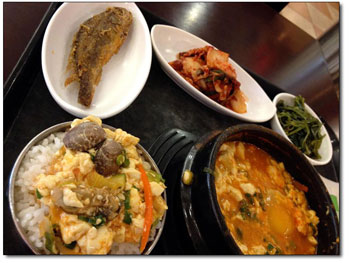|
|
From hippies to hipsters: tofu as haute cuisineby Ari LeVaux The Vegas Chinatown is a fascinating place. It exists almost entirely in strip malls, which are creeping westward along Spring Mountain road like expanding coral reefs, each storefront blinking neon, often in symbols or mysterious Asian characters. So enticing are the options that it’s tough to make it past the first block or two. In addition to the Korean tofu houses, there’s a mix of Filipino, Malayan, Laotian, Taiwanese, and Singaporean restaurants, as well as regional cuisines like Szechuan and niche players like noodle houses, Vietnamese sandwich shops, and even “Hot N Juicy Crawfish.” While attending a conference in Sin City recently, I stole off to Chinatown whenever possible. This was the trip, I had promised myself, that I’d explore the Vegas tofu houses. And Mr. Tofu – my first stop – did not disappoint, and my explorations continued. There’s something thrilling about a tofu dish that includes meat. It’s a validation of tofu as an ingredient in its own right, rather than a mere substitute for meat, and the contrasts between proteins can be stunning. With soondubu, a red chile broth with chunks of meat is loaded with delicate, broken pieces of extra-soft tofu. The tofu floats on top like curdles of cream, crowding the surface. It arrives bubbling at your table in a clay pot, often with a just-cracked egg lurking inside. The tofu flesh is chalky white when the spoon cuts through it, so soft you can slurp it. It’s a custardy island of non-flavor in an otherwise busy stew that’s further complicated by an assortment of banchan, Korean for “little dishes of vegetables and whatnot.” Banchan can include pickled daikon, seasoned soybean sprouts, kimchi, dried radish, or seaweed salad. At Vegas’ Greenland Market food court, which has the best soondubu I sampled, the stall in the corner includes a six-inch, pan-fried fish as a banchan. The most common meats used in soondubu are beef, pork and shellfish. Vegetarian versions include kimchi and mushroom/onion. Eaters typically adjust their soup by adding banchan to it, or alternatively combine the soup and banchan in the accompanying bowl of rice. Unless you get to the egg right away, it will be at least soft-boiled by the time you find it. Having returned home from that trip with deep appreciation and craving for soondubu, I visited a Korean store for ingredients. To my great joy, I discovered a little café in the back where they serve soondubu jjigae. After slurping down a bowl, I asked the store’s owner to help me find the ingredients. Most crucial is the tofu itself. It must be extra-soft (or “extra-silken”). The brand I got, named only in Korean, has a picture of soondubu on the package. The package does say the English words: “extra-soft” and “contains soy.” I guess that’s all I needed to know. Based on what I was told at the store, and from poking around online, I’ve put together a recipe for venison and wild mushroom soondubu that could hold its own on Spring Mountain road. It’s adapted from a beef and shiitake mushroom recipe, so you could use those ingredients instead. You could also follow the recipe more loosely with clams, or mixed seafood. “But not seafood and beef together,” the store owner warned, though others might disagree. She offered to sell me a soup flavor packet, but I wanted to do the whole thing from scratch. I started by making the stock. For two servings of stew, heat five cups water in a pot, add a fist-full of six-inch dried kelp pieces, four whole cloves of garlic, half an onion in one piece, a teaspoon of anchovy paste or a few squirts of fish sauce, and four shiitake mushrooms (or morels or porcini), dried or fresh. Meanwhile, cut meat into domino-sized pieces or smaller and sauté them in oil in the bottom of the pot in which you will cook and serve your soondubu. This would ideally be a clay pot, but a cast iron pan or Dutch oven works. Fish the mushrooms out of the stock pot, chop, and add them to the meat frying in the soup pot. Then add vegetables. Summer squash like zucchini are favored in most restaurant soondubu I’ve eaten, so at the Korean grocery I bought a blue-gray oval summer squash that came carefully wrapped in paper. Other options are julienned carrots, minced garlic or onion, and kimchi. Let your meat and veggies cook together (but don’t add the kimchi yet). Then add the stock. As it comes to a boil, add red chile powder, a little at a time, until it’s the right heat. Add a splash of sesame oil, and soy sauce to taste. Cut your tofu, a 14-oz package or two, depending on how much room there is. You want the broth packed. I use a butter knife to cut an elongated # sign into the rectangular piece of tofu, and then dump the nine pieces into the pot, stirring gently. I let these big chunks break into smaller pieces on their own. Add your kimchi now, if you like. When the stew reaches a rolling boil, crack an egg per person into the pot (or one egg into each single-serving clay pot). Don’t let the stew boil for longer than 30 seconds after adding the eggs, and then turn off the heat. Garnish with chopped green onions and a sliced jalapeño. Serve with rice and any banchan you can get your hands on. You may soon find yourself working on your banchan recipes, because after your first bowl of soondubu, odds are you’ll soon come back for more. |


